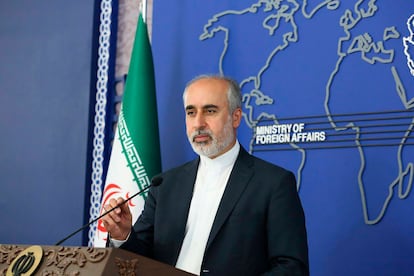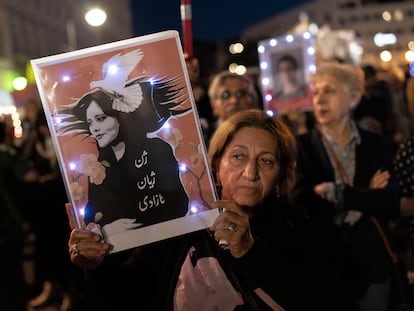Official says 5 prisoners sought by the US in a swap with Iran have flown out of Tehran
Iranian Foreign Ministry spokesman Nasser Kanaani was the first to acknowledge the swap would take place Monday

Five prisoners sought by the U.S. in a swap with Iran flew out of Tehran on Monday, an official said.
Flight-tracking data analyzed by the AP showed a Qatar Airways flight take off at Tehran’s Mehrabad International Airport, which has been used for exchanges in the past. Iranian state media soon after said the flight had left Tehran.
The official spoke to The Associated Press on condition of anonymity because the exchange was still in process.
Earlier, officials said that the exchange would take place after nearly $6 billion in once-frozen Iranian assets reached Qatar, a key element of the planned swap.
Despite the deal, tensions are almost certain to remain high between the U.S. and Iran, which are locked in various disputes, including over Tehran’s nuclear program. Iran says the program is peaceful, but it now enriches uranium closer than ever to weapons-grade levels.
Iranian Foreign Ministry spokesman Nasser Kanaani was the first to acknowledge the swap would take place Monday. He said the cash sought for the exchange that had been held by South Korea was now in Qatar.
Kanaani made his comments during a news conference aired on state television, but the feed cut immediately after his remarks.
“Fortunately Iran’s frozen assets in South Korea were released and God willing today the assets will start to be fully controlled by the government and the nation,” Kanaani said.
“On the subject of the prisoner swap, it will happen today and five prisoners, citizens of the Islamic Republic, will be released from the prisons in the U.S.,” he added. “Five imprisoned citizens who were in Iran will be given to the U.S. side.”
He said two of the Iranian prisoners will stay in the U.S.
The official said that both Iranian and U.S. officials had been notified by Qatar that the money had been transferred to the Gulf Arab nation, which serves as a go-between for the U.S. and Iran.
Mohammad Reza Farzin, Iran’s Central Bank chief, later came on state television to acknowledge the receipt of over 5.5 billion euros — $5.9 billion — in accounts in Qatar. Months ago, Iran had anticipated getting as much as $7 billion.
Washington did not comment on the announcement. The planned exchange comes ahead of the convening of world leaders at the U.N. General Assembly this week in New York, where Iran’s hard-line President Ebrahim Raisi will speak.
A Qatar Airways plane landed Monday morning at Mehrabad International Airport in Tehran, according to flight-tracking data analyzed by the AP. Qatar Airways uses Tehran’s Imam Khomeini International Airport for its commercial flights, but previous prisoner releases have taken place at Mehrabad.
The announcement by Kanaani comes weeks after Iran said that five Iranian-Americans had been transferred from prison to house arrest as part of a confidence-building move. Meanwhile, Seoul allowed the frozen assets, held in South Korean won, to be converted into euros.
The planned swap has unfolded amid a major American military buildup in the Persian Gulf, with the possibility of U.S. troops boarding and guarding commercial ships in the Strait of Hormuz, through which 20% of all oil shipments pass.
The deal has also already opened U.S. President Joe Biden to fresh criticism from Republicans and others who say that the administration is helping boost the Iranian economy at a time when Iran poses a growing threat to American troops and Mideast allies. That could have implications in his reelection campaign as well.
On the U.S. side, Washington has said the planned swap includes Siamak Namazi, who was detained in 2015 and was later sentenced to 10 years in prison on spying charges; Emad Sharghi, a venture capitalist sentenced to 10 years; and Morad Tahbaz, a British-American conservationist of Iranian descent who was arrested in 2018 and also received a 10-year sentence. All of their charges have been widely criticized by their families, activists and the U.S. government.
U.S. official have so far declined to identify the fourth and fifth prisoner.
The five prisoners Iran has said it seeks are mostly held over allegedly trying to export banned material to Iran, such as dual use electronics that can be used by a military.
The cash represents money South Korea owed Iran — but had not yet paid — for oil purchased before the U.S. imposed sanctions on such transactions in 2019.
The U.S. maintains that, once in Qatar, the money will be held in restricted accounts and will only be able to be used for humanitarian goods, such as medicine and food. Those transactions are currently allowed under American sanctions targeting the Islamic Republic over its advancing nuclear program.
Iranian government officials have largely concurred with that explanation, though some hard-liners have insisted, without providing evidence, that there would be no restrictions on how Tehran spends the money.
Iran and the U.S. have a history of prisoner swaps dating back to the 1979 U.S. Embassy takeover and hostage crisis following the Islamic Revolution. Their most recent major exchange happened in 2016, when Iran came to a deal with world powers to restrict its nuclear program in return for an easing of sanctions.
Four American captives, including Washington Post journalist Jason Rezaian, flew home from Iran at the time, and several Iranians in the U.S. won their freedom. That same day, then-President Barack Obama’s administration airlifted $400 million in cash to Tehran.
The West accuses Iran of using foreign prisoners — including those with dual nationality — as bargaining chips, an allegation Tehran rejects.
Negotiations over a major prisoner swap faltered after then-President Donald Trump unilaterally withdrew America from the nuclear deal in 2018. From the following year on, a series of attacks and ship seizures attributed to Iran have raised tensions.
Meanwhile, Iran’s nuclear program now enriches closer than ever to weapons-grade levels. While the head of the United Nations’ nuclear watchdog has warned that Iran now has enough enriched uranium to produce “several” bombs, months more would likely be needed to build a weapon and potentially miniaturize it to put it on a missile — if Iran decided to pursue one.
Iran maintains its nuclear program is peaceful, and the U.S. intelligence community has kept its assessment that Iran is not pursuing an atomic bomb.
Iran has taken steps in recent months to settle some issues with the International Atomic Energy Agency. But the advances in its program have led to fears of a wider regional conflagration as Israel, itself a nuclear power, has said it would not allow Tehran to develop the bomb. Israel bombed both Iraq and Syria to stop their nuclear programs, giving the threat more weight. It also is suspected in carrying out a series of killings targeting Iran’s nuclear scientists.
Iran also supplies Russia with the bomb-carrying drones Moscow uses to target sites in Ukraine in its war on Kyiv, which remains another major dispute between Tehran and Washington.
Sign up for our weekly newsletter to get more English-language news coverage from EL PAÍS USA Edition
Tu suscripción se está usando en otro dispositivo
¿Quieres añadir otro usuario a tu suscripción?
Si continúas leyendo en este dispositivo, no se podrá leer en el otro.
FlechaTu suscripción se está usando en otro dispositivo y solo puedes acceder a EL PAÍS desde un dispositivo a la vez.
Si quieres compartir tu cuenta, cambia tu suscripción a la modalidad Premium, así podrás añadir otro usuario. Cada uno accederá con su propia cuenta de email, lo que os permitirá personalizar vuestra experiencia en EL PAÍS.
¿Tienes una suscripción de empresa? Accede aquí para contratar más cuentas.
En el caso de no saber quién está usando tu cuenta, te recomendamos cambiar tu contraseña aquí.
Si decides continuar compartiendo tu cuenta, este mensaje se mostrará en tu dispositivo y en el de la otra persona que está usando tu cuenta de forma indefinida, afectando a tu experiencia de lectura. Puedes consultar aquí los términos y condiciones de la suscripción digital.
More information
Archived In
Últimas noticias
Most viewed
- Sinaloa Cartel war is taking its toll on Los Chapitos
- Oona Chaplin: ‘I told James Cameron that I was living in a treehouse and starting a permaculture project with a friend’
- Reinhard Genzel, Nobel laureate in physics: ‘One-minute videos will never give you the truth’
- Why the price of coffee has skyrocketed: from Brazilian plantations to specialty coffee houses
- Silver prices are going crazy: This is what’s fueling the rally










































